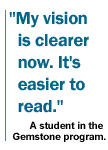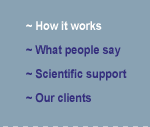
Dynamic Vision Training© includes three phases: vision screening, professional assessment and referral, and vision training.

The first step is deciding who will participate in the initial vision screening. Your school chooses the criteria for selecting students. For example, an elementary school could choose to screen all students with standardized reading scores below a certain level. A high school might decide to screen all incoming freshmen on a routine basis.
At the same time, Gemstone makes sure the school's computers have adequate capacity to interact with its programs via the internet. Nothing to install on any of the school's computers!
After the students are selected, the screening begins. This phase identifies visual processing problems -- beyond the need for optical correction.
Visual screening includes patent-pending technology to measure and record both visual acuity and visual skills scores ...
- Student History Form: Each student completes a brief questionnaire to identify any subjective symptoms and their severity. The information is transmitted to Gemstone's server for analysis.
- Modified Clinical Technique plus (MCT+): At the school, Gemstone doctors measure visual acuity, refractive error and eye muscle balance for visual targets near and far. They also assess near focusing range, accommodative facility, near point of convergence and vergence ranges, and inspect the eyes for general health. The doctors transmit the results of the MCT+ directly to the Gemstone server for analysis.
- Developmental Eye Movement test (DEM): The DEM is a nationally standardized test that aids in assessing reading-related eye movements. It's a paper-and-pencil test that's easy to administer. Results are recorded on a Gemstone interactive Web page, and transmitted to the Gemstone server.
- Visagraph recording (optional): Gemstone doctors administer the Taylor Visagraph test, which is designed to assess students' eye movements while reading. Saccadic and reset patterns are compared to standards based on reading level. Visagraph results are transmitted to Gemstone electronically, and added to student data files.
Throughout Phase I, Gemstone trains teachers and aides to administer selected tests for detecting Visual Efficiency Syndrome (VIS). This allows schools to perform tests of visual skills when they want to, and to do them on a routine basis.
Find out what happens in Phase II ...
                      
|




